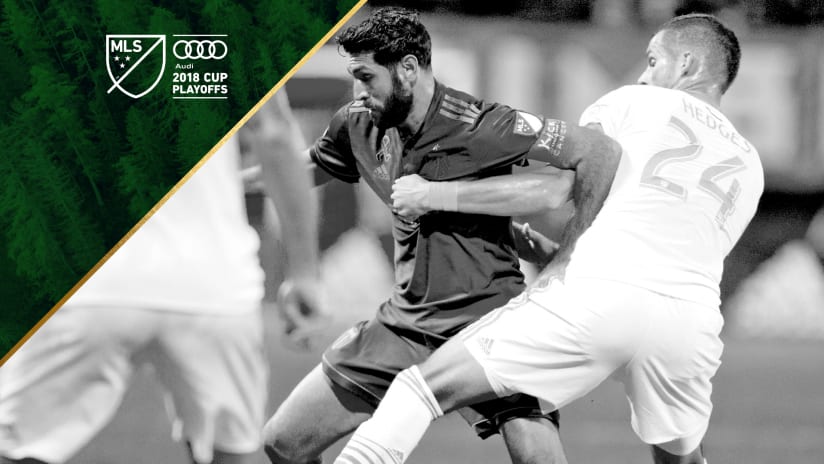From the outside, FC Dallas’ late-season struggles might feel inexplicable, particularly considering the trajectory the organization has charted since Óscar Pareja, a former FCD midfielder, returned as head coach in 2014. The team endured a late-season swoon in 2017, too, and eventually finished seventh in the Western Conference, but in Pareja’s previous seasons in charge, the team had finished fourth, first, and first in what’s generally been MLS’ strongest conference. In the postseason for four seasons in five, FC Dallas is an organization that’s become accustomed to playing late into the calendar.
This season, though, the team enters the postseason having lost three in a row. They haven’t defeated a playoff team since July 28, when they won at Sporting Kansas City. They have been shutout in three of their last five games, and over their last 270 minutes, FC Dallas has been outscored 6-1. Those are generally considered bad things, in terms of (industry term coming) soccer stuffs.
Portland may be the lower seed on Wednesday in the Audi 2018 MLS Cup Playoffs Knockout Round match (6:30pm PT, ROOT SPORTS | Match presented by Spirit Mountain Casino), and the fact they had to travel for the league’s Knockout Round hints the team should be seen as an underdog. But within the last month’s results, there’s reason to think Wednesday’s meeting could go in Portland’s favor, something that plays out when you consider the matchups.
FC Dallas’ attack versus Portland’s defense
Maxi Urruti and Dominique Badji present of set of physical threats that would concern any team. Between their speed, movement and willingness, the duo could be one of the best attacking duos in Major League Soccer. Each opponent traveling to Toyota Stadium has to grapple with that potential.
But there is a reason that Dallas has only scored once in the last 270 minutes. Against playoff teams, Dallas has not scored in their last 398 minutes. This is an attack which, since the mid-summer of its defining component, has been searching for definition, and although talents like Urruti, Badji and wingers Micheal Barrios and Roland Lamah present physical challenge to rival any team’s in MLS, the chemistry amongst those talents has produced few rewards over MLS’ final months.
In theory, that puts Wednesday’s defensive performance in the hands of the Timbers, who seem set to start Larrys Mabiala and Liam Ridgewell in central defense. As we discussed a week ago, the Timbers are only giving up 0.79 goals per 90 minutes when their first-choice center-back tandem starts in the middle, and only 0.25 goals per 90 since the season’s second week. While those numbers have rarely been tested on the road (with the duo having only played together once, during a shutout in San Jose, since), there is little doubt that a Mabiala and Ridgewell combination are a part of Portland’s potential.
On Wednesday, that potential needs to meet product. That’s what the postseason is about. And while there are certainly questions to be answered further up the field (and in the last two sections of this post), Portland’s life gets a lot easier of Mabiala and Ridgewell are at their best in Frisco.
Portland’s midfield versus FC Dallas’ midfield
Ever since Mauro Díaz left Dallas, moving on to a new soccer life in the Middle East, the team has had an identity problem, one that more manifests in how the team tries to play, for now, than how it defines itself around or off the field. In those other areas, Pareja’s vision and philosophy remain defining traits – a good thing, given the coach’s resume and reputation. How that philosophy meets Dallas’ post-Diaz, on-field world, though, remains to be seen.
With the Argentine at the tip of midfield, the team had a consistent focal point in attack – a player whose presence on the ball was to both definitional and, on a play-by-play basis, almost mandatory. The skill with which he hit a through ball into the space between opposing defenses and goalkeepers was unmatched in Major League Soccer – a skill that meshed adoringly with the pursuing skills of Urruti and Barrios. With him gone, however, Dallas needed to figure out an approach they could rely on, without which, they were without definition.
Most onlookers call FC Dallas’ current system a 4-2-3-1, with Urruti dropping back from his previous, higher forward spot to fill the space Diaz cast off, but 10 years ago, that approach would still be called a 4-4-2. Urruti is not doing the same things as Diaz; not emulating players like Columbus’ Federico Higuaín, Atlanta United’s Miguel Almirón, or MLS co-assist leader, Philadelphia’s Borek Dockal. It’s as if 4-4-2 has become a pejorative, and we can’t talk about how pigeon holing most formations into “4-2-3-1” is detrimental to what we should be communicating about teams’ approaches.
That’s on us, not Óscar Pareja. He knows what he’s got, but in the wake of Diaz’s departure, he also has a problem. The gap between Urruti and the team’s two deep midfielders, Carlos Gruezo and Victor Ulloa, creates an imbalance, with no Dallas player able to be effectual in a space that often plays out as the most important on the park.
Diego Chará dominates those grounds. David Guzmán can be influential there, too, and as Sebastián Blanco has become a more versatile player in year two in MLS, under Giovanni Savarese, he too can adopt a strong No. 8’s pose.
That, however, creates a problem for Dallas, and if Portland wins the midfield battle, that means more time for Diego Valeri, Blanco, and the Timbers who’ll be next to get the ball to define the game at the next level of the field.
Portland’s attack versus Dallas’ defense
By the numbers, this is where Portland might have trouble, which might make it more important that the Timbers execute on their counter attacks, if they’re afforded the same opportunities they had at Providence Park. But if Dallas centerback Matt Hedges can get his line organized, and the Timbers have to break down a Pareja defense which, if nothing else holds, will at least be organized, Wednesday’s game could play out exactly like the last time the teams met, in Portland. There is a reason why Dallas’s defense conceded the fourth-fewest goals in MLS, this season.
Here’s why it’s so hard to know about this phase of the game, though: The Timbers played a 4-3-2-1 when the teams first met, this winter in Dallas; they played a 4-3-1-2 during the scoreless draw at Providence Park; if the team plays 4-2-3-1 at Toyota Stadium and, as is hinted by their two games playing the formation against Real Salt Lake, play better than they have at previous points, this season, what can we truly infer from Portland’s previous results?
Jeremy Ebobisse’s play off the ball can offset the numbers issue. He’s willing to move away from play, drag one of Hedges and Reto Zeigler with him, and leave Dallas defenders isolated for teammates’ runs. The question is, as players like Jorge Villafaña, Zarek Valentinor Alvas Powell get forward (pick the two you want to start at fullback) to help create outnumbered situations, who moves into these dangerous areas in the penalty area? Who helps offset that fact that the Timbers will not only be starting one striker up top but players like Valeri and Blanco often need to contribute in areas far from goal?
That is why you’ve seen The Blanco Play – him coming from the left; getting into the channel between the opposition left back and left-center back; firing a ball toward the far post – be so effective. It is why that play has produced multiple goals for Ebobisse, another for Chara, and a brilliant chance for Lucas Melano, over the last two months of the regular season. It is why the numbers game the Timbers lose along the defense can be compensated for in front of the opponents’ line, where attention paid to players like Valeri allows the team’s Blancos to find the ball, turn the defense, and let Ebobisse exploit spaces opponents have forgot.
It’s why Dallas have a problem on Wednesday at Toyota Stadium. It’s part of the reason why the Timbers’ change of formation might, if they play a 4-2-3-1, prove very important in the Knockout Round. It’s also contributes to why, despite playing away from home, the Timbers should be optimistic about their changes on the road.












